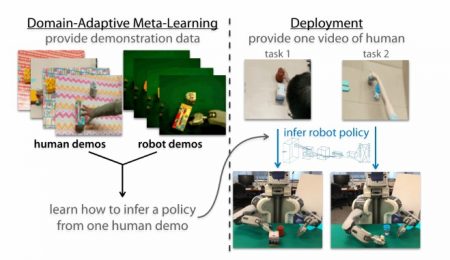July 5, 2018 – At the Berkeley Artificial Intelligence Laboratory in California, robots are learning using one-shot imitation, that is observing someone or something else, such as another robot, manipulating an object, and then doing the same. No coding required. No repetition. The robot is learning by imitating but unlike in the past, observing an action once and then carrying out the same act flawlessly.
Imitating through learning from another robot is far easier than learning from a human action. After all, the mechanics of two nearly identical machines tend to work the same way. But learning to do what humans do means performing the same skill using non-human parts. After all, a robot’s arms and grasping ability are far different from those possessed by humans.
What the Berkeley researchers did is first combine a human physical demonstration with observed learning from watching lots of video of both human and robots doing a task. The process is called domain-adaptive meta-learning with the robot learning about the basic task requirements without actually doing it. Later the researchers substituted a video demonstration in place of a live human demonstration. The robot in both cases demonstrated its ability to execute the operation nearly flawlessly in a single try.
The next step for this Berkeley team is to expose their robot to multiple tasks using the same processes allowing the machine to become capable of more diverse jobs and capable of adjusting to new situations thrown at it. They have written a paper on their work entitled, “One-Shot Visual Imitation Learning via Meta-Learning” in which they state that their method will make it possible for robots to increase capability through “raw pixel inputs and data from significantly fewer prior tasks for effective learning of new skills.”
This is an impressive accomplishment bringing machines closer to being able to match human learning when performing simple mechanical tasks. But don’t be too intimidated by this. We humans are still way ahead in doing reasoning tasks and it will be some time before the machines can match how we learn.
















